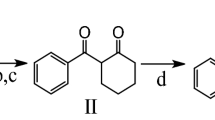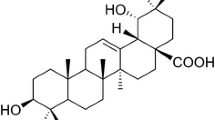Abstract
In the present study, the antinociceptive profiles of vanillin were examined in ICR mice. Vanillin administered orally (from 1 to 10 mg/kg) showed an antinociceptive effect in a dose-dependent manner as measured in the acetic acid-induced writhing test. Duration of antinociceptive action of vanillin maintained at least for 30 min. But, the cumulative response time of nociceptive behaviors induced by a subcutaneous (s.c.) formalin injection, intrathecal (i.t.) substance P (0.7 µg) or glutamate (20 µg) injection was not affected by vanillin. Intraperitoneal (i.p.) pretreatment with yohimbine (α2-adrenergic receptor antagonist) or naloxone (opioid receptor antagonist) attenuated antinociceptive effect induced by vanillin in the writhing test. However, phentolamine (α1-adrenergic receptor antagonist) or methysergide (5-HT serotonergic receptor antagonist) did not affect antinociception induced by vanillin in the writhing test. Our results suggest that vanillin exerts a selective antinociceptive property in the acetic acidinduced visceral inflammatory pain model. Furthermore, this antinociceptive effect of vanillin may be mediated by α2-adrenergic and opioid receptors, but not α1-adrenergic and serotonergic receptors.
Similar content being viewed by others
References
Abraham, D. J., Mehanna, A. S., Wireko, F. F., Whitney, J., Thomas, R. P., and Orringer, E. P., Vanillin, a potential agent for the treatment of sickle cell anemia. Blood, 77, 1334–1341 (1991).
Akagi, K., Hirose, M., Hoshiya, T., Mizoguchi, Y., Ito, N., and Shirai, T., Modulating effects of ellagic acid, vanillin and quercetin in a rat medium term multi-organ carcinogenesis model. Cancer Lett., 94, 113–121 (1995).
Cervero, F. and Laird, J. M. A., Visceral pain. Lancet, 353, 2145–2148 (1999).
Choi, S. S., Han, K. J., Lee, J. K., Lee, H. K., Han E. J., Kim, D. H., and Suh, H. W., Antinociceptive mechanisms of orally administered decursinol in the mouse. Life Sci., 73, 471–485 (2003).
Choi, S. S., Lee, J. K., and Suh, H. W., Antinociceptive profiles of aspirin and acetaminophen in formalin, Substance P and glutamate pain models. Brain Res., 921, 233–239 (2001).
Chung, K. M., Lee, K. C., Choi, S. S., and Suh, H. W., Differential roles of spinal cholera toxin- and pertussis toxin sensitive G proteins in nociceptive responses caused by formalin, capsaicin and substance P in mice. Brain Res. Bull., 54, 537–542 (2001).
Cumberbatch, M. J., Herrero, J. H., and Headley, P. M., Exposure of rat spinal neurons to NMDA, AMPA and kainate produces only short-term enhancements of responses to noxious and non-noxious stimuli. Neurosci. Lett., 181, 98–102 (1994).
Emanuel, E. J. and Emanuel, L. L., Palliative and end-of-life care. In: Kasper, D. L., Fauci, A. S., Longo, D. L., Braunwald, E., Hauser, S. L., Jameson, J. L., eds. Harrison’s principles of internal medicine. 16th ed. McGraw-Hill Medical Publishing Division, New York, pp. 53–66, (2005).
Fahrig, R., Anti-mutagenic agents are also co-recombinogenic and can be converted into co-mutagens. Mutat. Res., 350, 59–67 (1996).
Giamberardino, M. A., Recent and forgotten aspects of visceral pain. European Journal of Pain, 3, 77–92 (1999).
Hogman, S., Prevention of cancer; vegetables and plants. Comp. Biochem. Physiol., 93B, 201–212 (1989).
Hunskaar, S., Fasmer, O. B., and Hole, K., Formalin test in mice, a useful technique for evaluating mild analgesics. J. Neurosci. Methods, 14, 69–76 (1985).
Hunskaar, S. and Hole, K., The formalin test in mice: dissociation between inflammatory and non-inflammatory pain. Pain, 30, 103–114 (1987).
Hylden, J. L. and Wilcox, G. L., Intrathecal morphine in mice: A new technique. Eur. J. Pharmacol., 67, 313–316 (1980).
Hylden, J. L. and Wilcox, G. L., Intrathecal substance P elicits a caudally-directed biting and scratching behavior in mice. Brain Res., 217, 212–215 (1981).
Jensen, T. S. and Yaksh, T. L., Spinal monoamine and opiate systems partly mediate the antinociceptive effects produced by glutamate at brainstem sites. Brain Res., 321, 287–297 (1984).
Koster, R., Anderson, M., and Beer, E. J., Acetic acid for analgesic screening. Federal Proceeding, 18, 412 (1959).
Kurihara, T., Nonaka, T., and Tanabe, T., Acetic aicd conditioning stimulus induces long-lasting antinociception of somatic inflammatory pain. Pharmacol. Biochem. Behav., 74, 841–849 (2003).
Kumar, S. S., Priyadarsini, K. I., and Sainis, K. B., Inhibition of peroxynitrite-mediated reactions by vanillin. J. Agric. Food Chem., 52, 139–145 (2004).
Lee, J. Y., Jang, Y. W., Kang, H. S., Moon, H., Sim, S. S., and Kim, C. J., Anti-inflammatory action of phenolic compounds from Gastrodia elata root. Arch. Pharm. Res., 29, 849–858 (2006).
Puig, S. and Sorkin, L. S., Formalin-evoked activity in identified primary afferent fibers: systemic lidocaine suppresses phase-2 activity. Pain, 64, 345–355 (1989).
Reichert, J. A., Daughters, R. S., Rivard, R., and Simone, D. A., Peripheral and preemtive opioid antinociception in a mouse visceral pain model. Pain, 89, 221–227 (2001).
Rorarius, M. G., Mennander, S., Suominen, P., Rintala, S., Puura, A., Pirhonen, R., Salmelin, R., Haanpaa, M., Kujansuu, E., and Yli-Hankala, A., Gabapentin for the prevention of postoperative pain after vaginal hysterectomy. Pain, 110, 175–181 (2004).
Sanyal, R., Darrouti, F., Parzefall, M., Nagao, M., and Knasmuller, S., Inhibition of the genotoxic effects of heterocyclic amines in human derived hepatoma cells by dietary bioantimutagens. Mutagenesis, 12, 297–303 (1997).
Satyanarayana, P. S. V., Jain, N. K., Singh, A., and Kulkarni, S. K., Isobolographic analysis of interaction between cyclooxigenase inhibitors and tramadol in acetic acid-induced writhing in mice. Prog. Neuropsychopharmacol., 28, 641–649 (2004).
Sawa, T., Nakao, M., Akaike, T., Ono, K., and Maeda, H., Alkylperoxyl radical-scavenging activity of various flavonoids and other phenolic compounds: implications for the anti-tumour promoter effect of vegetables. J. Agric. Food Chem., 47, 397–402 (1999).
Schmauss, C. and Yaksh, T. L., In vivo studies on spinal opiate receptor systems mediating antinociception. II. Pharmacological profiles suggesting a differential association of mu, delta and kappa receptors with visceral chemical and cutaneous thermal stimuli in the rat. J. Pharmacol. Exp. Ther., 228, 1–12 (1984).
Shibata, M., Ohkubo, T., Takahashi, H., and Inoki, R., Modified formalin test: characteristic biphasic pain response. Pain, 38, 347–352 (1989).
Suh, H. W., Song, D. K., Son, K. H., Wie, M. B., Lee, K. H., Jung, K. Y., Do, J. C., and Kim, Y. H., Antinociceptive mechanisms of dipsacus saponin C administered intracerebroventricularly in the mouse. Gen. Pharmacol., 27, 1167–1172 (1996).
Suh, H. W., Song, D. K., and Kim, Y. H., Differntial effects of adenosine receptor antagonist injected intrathecally on antinociception induced by morphine and beta-endorphin administered intracerebroventricularly in the mouse. Neuropeptides, 31, 339–344 (1997).
Suh, H. W., Chung, K. M., Kim, Y. H., Huh, S. O., and Song, D. K., Effect of histamine receptor antagonists injected intrathecally on antinociception induced by opioids administered intracerebroventricularly in the mouse. Neuropeptides, 33, 121–129 (1999).
Tsuda, H., Uehara, N., Iwahori, Y., Asamoto, M., Iigo, M., Nagao, M., Matsumoto, K., Ito, M., and Hirono, I., Chemopreventive effects of beta-carotene, alpha-tocopherol and five naturally occurring antioxidants on initiation of hepatocarcinogenesis by 2-amino-3methylimidazo[4,5-f] quinoline in the rat. Jpn. J. Cancer Res., 85, 1214–1219 (1994).
Ulugol, A., Ozyigit, F., Yesilyurt, O., and Dogrul, A., The additive antinociceptive interaction between WIN 55,212-2, a cannabinoid agonist, and ketorolac. Anesth. Analg., 102, 443–447 (2006).
Vyklicky, L., The techniques for the study of pain in animals. In: Bonica, J. J, Liebeskind, J. C., Albe-Fessard, D. G., editors. Advances in Pain Research and Theraphy, Vol. 3. Raven, New York, pp. 727–745, (1979).
Wigdor, S. and Wilcox, G. L., Central and systemic morphine-induced antinociception in mice: contribution of descending serotonergic and noradrenergic pathways. J. Pharmacol. Exp. Ther., 242, 90–95 (1987).
Wilkie, D., Antimitochondrial drugs in cancer chemotherapy: preliminary communication. J. R. Soc. Med., 72, 299–601 (1979).
Yaksh, T. L., Direct evidence that spinal serotonin and noradrenaline terminals mediate the spinal antinpciceptive effects of morphine in the periaqueductal gray. Brain Res., 160, 180–185 (1979).
Yaksh, T. L., Multiple opioid receptor systems in brain and spinal cord: Part I. Eur. J. Anaesthesiol., 1, 171–199 (1984).
Yaksh, T. L., Opiate receptors for behavioral analgesia resemble those related to the depression of spinal nociceptive neurons. Science, 199, 1231–1233 (1978).
Author information
Authors and Affiliations
Corresponding author
Rights and permissions
About this article
Cite this article
Park, SH., Sim, YB., Choi, SM. et al. Antinociceptive profiles and mechanisms of orally administered vanillin in the mice. Arch. Pharm. Res. 32, 1643–1649 (2009). https://doi.org/10.1007/s12272-009-2119-8
Received:
Revised:
Accepted:
Published:
Issue Date:
DOI: https://doi.org/10.1007/s12272-009-2119-8




